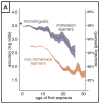A critical period for second language acquisition: Evidence from 2/3 million English speakers
- PMID: 29729947
- PMCID: PMC6559801
- DOI: 10.1016/j.cognition.2018.04.007
A critical period for second language acquisition: Evidence from 2/3 million English speakers
Abstract
Children learn language more easily than adults, though when and why this ability declines have been obscure for both empirical reasons (underpowered studies) and conceptual reasons (measuring the ultimate attainment of learners who started at different ages cannot by itself reveal changes in underlying learning ability). We address both limitations with a dataset of unprecedented size (669,498 native and non-native English speakers) and a computational model that estimates the trajectory of underlying learning ability by disentangling current age, age at first exposure, and years of experience. This allows us to provide the first direct estimate of how grammar-learning ability changes with age, finding that it is preserved almost to the crux of adulthood (17.4 years old) and then declines steadily. This finding held not only for "difficult" syntactic phenomena but also for "easy" syntactic phenomena that are normally mastered early in acquisition. The results support the existence of a sharply-defined critical period for language acquisition, but the age of offset is much later than previously speculated. The size of the dataset also provides novel insight into several other outstanding questions in language acquisition.
Keywords: Critical period; L2 acquisition; Language acquisition.
Copyright © 2018 Elsevier B.V. All rights reserved.
Figures








Comment in
-
With Great Data Comes Great (Theoretical) Opportunity.Trends Cogn Sci. 2018 Aug;22(8):669-671. doi: 10.1016/j.tics.2018.05.011. Epub 2018 Jun 11. Trends Cogn Sci. 2018. PMID: 29903691
References
-
- Abrahamsson N. Age of onset and nativelike L2 ultimate attainment of morphosyntactic and phonetic intuition. Studies in Second Language Acquisition. 2012;34(02):187–214.
-
- Abrahamsson N, Hyltenstam K. The robustness of aptitude effects in near-native second language acquisition. Studies in Second Language Acquisition. 2008;30(4):481–509.
-
- Abrahamsson N, Hyltenstam K. Age of onset and nativelikeness in a second language: Listener perception versus linguistic scrutiny. Language Learning. 2009;59(2):249–306.
-
- Baayen RH, Davidson DJ, Bates DM. Mixed-effects modeling with crossed random effects for subjects and items. Journal of Memory and Language. 2008;59:390–412.
-
- Berman RA, editor. Language development across childhood and adolescence. Philadelphia, PA: John Benjamins Publishing Company; 2004.
Publication types
MeSH terms
Grants and funding
LinkOut - more resources
Full Text Sources
Other Literature Sources

